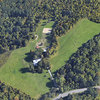$1M for arbitration on top of a $2M cost increase: New Scotland Rail Trail Bridge starts to get real pricy
SLINGERLANDS — After first presenting it to the public in 2019, Albany County became tight-lipped with its updates — other than saying it was engaged in litigation — on replacing the crumbling century-old bridge over New Scotland Road in Slingerlands.
No longer used by trains, the bridge was to be replaced with a walkway for cyclists and hikers on the rail trail, high enough that trucks would not keep slamming into it.
Over the past few months, a series of authorization votes and million-dollar arbiter decisions appear to have put the project back on track — albeit with a price tag far greater than originally anticipated.
On Aug. 8, the Albany County Legislature allocated $250,000 for Sprint to relocate its buried fiber-optic cables “along the length of the existing Albany County Rail Trail Bridge over New Scotland Road.”
The resolution states the lines will be dug up prior to the existing bridge’s demolition and temporarily hung from utility poles during construction of the new overpass, after which the lines will be strung along the outside of the new structure.
The Spotlight News was the first to report on the plan to relocate the lines.
Sprint expects the relocation work to cost about $200,000.
During the Aug. 8 meeting, legislators also approved a resolution authorizing the county to bond another $916,000 on the bridge project. The meeting agenda itself makes no mention of where the allocation is being spent; that information is located in 500 pages of accompanying documentation.
The county awarded the $2.7 million construction contract in May; coupled with the August addition, that brings the project cost to $3.6 million — a near 90-percent increase over the county’s 2019 chosen design in 2019, which was slated to cost $1.9 million.
Albany County spokeswoman Mary Rozak on Wednesday attributed the project-cost spike to a variety of factors: increased material costs, specifically steel prices; the additional $250,000 needed to relocate Sprint’s fiber-optic cable; and another unaccounted and not factored for $320,000 needed for drainage work on New Scotland Road, for which the state will reimburse the county.
Accounting for cable relocation and drainage work, the new bridge appears to have an estimated cost of $4.1 million, more than doubling the original projection.
Long legal history
Also in May, Albany County sent Sprint a wire for a little over $1 million to settle an arbitration case that had entangled the two sides for years.
Rozak, in response to emailed questions, told The Enterprise none of the newly-bonded money will go toward paying off the settlement. The county has a separate account for those types of payments, Rozak wrote, a claims and settlement fund, which receives an annual allocation of $4.7 million.
An Aug. 4 court filing states, “The County and Sprint disputed whether the construction of the Rail Trail necessitated relocation of the Telecommunications Facilities and whether the County was required to reimburse Sprint for the costs and expenses of relocation.”
The Albany County Helderberg-Hudson Rail Trail covers 9.8 miles from Voorheesville in New Scotland to the South End of Albany.
The parties could not come to an agreement over who should foot the bill for relocating Sprint’s cables, the filing states, and the two sides ultimately struck a deal where Sprint paid to move its own telecommunications “while reserving the right to seek reimbursement from the County.”
The original 2015 contract said, if Albany County and Sprint couldn’t come to agreement they would “submit any unresolved issues and other disputes to binding arbitration by a panel of three arbitrators selected by mutual agreement of the PARTIES.”
An earlier court filing associated with the case explained that Sprint’s predecessor, US Telecom, in 1986 signed a “twenty-year ‘Fiber Optic Easement Agreement’ to construct and maintain telecommunications lines running within a railroad right-of-way” in what today in the Albany County Helderberg-Hudson Rail Trail and at the time was a working railroad line.
The court papers state the right-of-way runs from near South Pearl Street in the city of Albany to the “intersection of New Scotland Road and Voorheesville Avenue in the Village of Voorheesville,” two roadways that do not intersect with one another.
In 2006, the court papers say, Sprint re-upped the agreement for another 20 years. But in December 2008, Canadian Pacific sold Albany County the “Trail Segment through which Sprint’s right-of-way ran.”
The 2018 filing notes Sprint had relocated its fiber along two segments of the rail trail — the cost to the company at the time was:
— $330,807.39 for the first segment, between South Pearl Street and Delaware Avenue; and
— $146,391.61 ($268,000, according to the latest filing) for the second, between Delaware Avenue and New Scotland Road.
Segment three is between New Scotland Road and Voorheesville Avenue.
The 2018 court filing says Albany County did not notify Sprint of its intention to begin work from Delaware Avenue to New Scotland Road, segment two, until after the county had paved over the company’s telecommunications, “thus substantially increas[ing] the cost of the Relocation Work,” which at time had a price tag of about $146,000.
The original arbitration agreement between the sides included a clause that said Sprint contended the paving of the rail trail would “inhibit access” to its telecommunications and that, under the circumstances, the county would be “obligated to pay 100% of the cost of the work necessary to relocate and encase” its lines. But the following clause stated the county “reasonably anticipates that the Project will not affect the [Sprint’s] facilities.”
In the 2018 court filing, Sprint requested to be reimbursed for its relocation work but the county denied the request. About five months later, according to the filing, Sprint asked for a telephone conference with the county — a request that was met with silence.
Demands, in a contractual sense, from Sprint were met with more foot-dragging from Albany County. But eventually the sides came to an agreement through arbitration in July 2018 — the pandemic appears to have ground proceedings to a halt — an evidentiary hearing took place in October 2021, with the three-member panel entering an interim decision in February, a final decision being made in mid-May, and the money in Sprint’s account by the end of May.
The bridge
The bridge was included as part of Albany County’s 2008 purchase of the rail trail.
Built in 1912, the bridge has been in rough shape for some time.
In 2019, the county said it had been struck by vehicles passing beneath it nine times in the previous 11 years. The Enterprise reported on another four incidents in 2021 alone.
A 2008 report said that the bridge’s structural steel and much of its concrete were in “very poor condition.”
A 2017 inspection by the New York State Department of Transportation said that the structure was in such bad shape, its deficiencies could “significantly impact” the bridge’s “load carrying capacity.” In 2018, the county made temporary repairs to the bridge.
In 2019, the county decided on the $1.9 million plan to remove the 42-foot wide existing bridge and replace it with a two-girder structure that is 14 feet wide, raising the structure to 15 feet, 6 inches above the roadway to meet state requirements.
Construction on the new bridge was to start in the summer of 2020 but it was slowed by the pandemic and litigation. A letter from the county’s engineer on the project — which had been included as part of its sixth supplemental agreement for work on the bridge approved by the county legislature in June, services which started at $95,500 and is currently $284,700 — says the firm is aware the existing bridge will remain in place until at least spring 2023.
According to Rozak, “fiber relocation will happen in the fall. The bridge will be removed and replaced in the 2023 construction season.”


